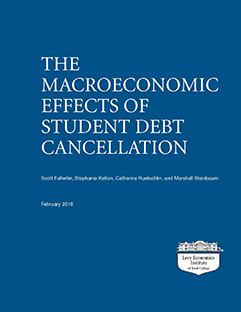
Research Topics
Publications on Household debt
There are 4 publications for Household debt.
-
Household Consumption, Household Indebtedness, and Inequality in Turkey
Working Paper No. 954 | April 2020A Microeconometric Analysis
This paper examines whether relative income and income inequality within reference groups affect household consumption. Using the explanations of consumption behavior based on Dusenberry’s relative income hypothesis, we test if household consumption levels in Turkey are affected by the household’s relative position and inequality in the reference group between 2005–12 by employing cross-sectional household-level data. We find that household consumption is negatively related to the relative income indicator after controlling for absolute income, and positively related to the income inequality of the reference group, as the literature suggests. The paper also shows that household indebtedness has a positive impact on household consumption when inequality in the reference group and the relative position of households are controlled for. We confirm that the results are not sensitive to chosen relative income indicators and income inequality.
Download:Associated Program:Author(s): -
Income Distribution, Household Debt, and Aggregate Demand
Working Paper No. 901 | March 2018A Critical Assessment
During the period leading up to the recession of 2007–08, there was a large increase in household debt relative to income, a large increase in measured consumption as a fraction of GDP, and a shift toward more unequal income distribution. It is sometimes claimed that these three developments were closely linked. In these stories, the rise in household debt is largely due to increased borrowing by lower-income households who sought to maintain rising consumption in the face of stagnant incomes; this increased consumption in turn played an important role in maintaining aggregate demand. In this paper, I ask if this story is consistent with the empirical evidence. In particular, I ask five questions: How much household borrowing finances consumption spending? How much has monetary consumption spending by households increased? How much of the rise in household debt-income ratios is attributable to increased borrowing? How is household debt distributed by income? And how has the distribution of consumption spending changed relative to the distribution of income? I conclude that the distribution-debt-demand story may have some validity if limited to the housing boom period of 2002–07, but does not fit the longer-term rise in household debt since 1980.Download:Associated Programs:Author(s):J. W. Mason -
The Macroeconomic Effects of Student Debt Cancellation
Research Project Report, February 2018 | February 2018 Among the more ambitious policies that have been proposed to address the problem of escalating student loan debt are various forms of debt cancellation. In this report, Scott Fullwiler, Research Associate Stephanie Kelton, Catherine Ruetschlin, and Marshall Steinbaum examine the likely macroeconomic impacts of a one-time, federally funded cancellation of all outstanding student debt.
Among the more ambitious policies that have been proposed to address the problem of escalating student loan debt are various forms of debt cancellation. In this report, Scott Fullwiler, Research Associate Stephanie Kelton, Catherine Ruetschlin, and Marshall Steinbaum examine the likely macroeconomic impacts of a one-time, federally funded cancellation of all outstanding student debt.
The report analyzes households’ mounting reliance on debt to finance higher education, including the distributive implications of student debt and debt cancellation; describes the financial mechanics required to carry out the cancellation of debt held by the Department of Education (which makes up the vast majority of student loans outstanding) as well as privately owned student debt; and uses two macroeconometric models to provide a plausible range for the likely impacts of student debt cancellation on key economic variables over a 10-year horizon.
The authors find that cancellation would have a meaningful stimulus effect, characterized by greater economic activity as measured by GDP and employment, with only moderate effects on the federal budget deficit, interest rates, and inflation (while state budgets improve). These results suggest that policies like student debt cancellation can be a viable part of a needed reorientation of US higher education policy.
Download:Associated Programs:Author(s): -
Fiscal Austerity, Dollar Appreciation, and Maldistribution Will Derail the US Economy
Strategic Analysis, May 2015 | May 2015In this latest Strategic Analysis, the Institute’s Macro Modeling Team examines the current, anemic recovery of the US economy. The authors identify three structural obstacles—the weak performance of net exports, a prevailing fiscal conservatism, and high income inequality—that, in combination with continued household sector deleveraging, explain the recovery’s slow pace. Their baseline macro scenario shows that the Congressional Budget Office’s latest GDP growth projections require a rise in private sector spending in excess of income—the same unsustainable path that preceded both the 2001 recession and the Great Recession of 2007–9. To better understand the risks to the US economy, the authors also examine three alternative scenarios for the period 2015–18: a 1 percent reduction in the real GDP growth rate of US trading partners, a 25 percent appreciation of the dollar over the next four years, and the combined impact of both changes. All three scenarios show that further dollar appreciation and/or a growth slowdown in the trading partner economies will lead to an increase in the foreign deficit and a decrease in the projected growth rate, while heightening the need for private (and government) borrowing and adding to the economy’s fragility.Download:Associated Program:Author(s):
